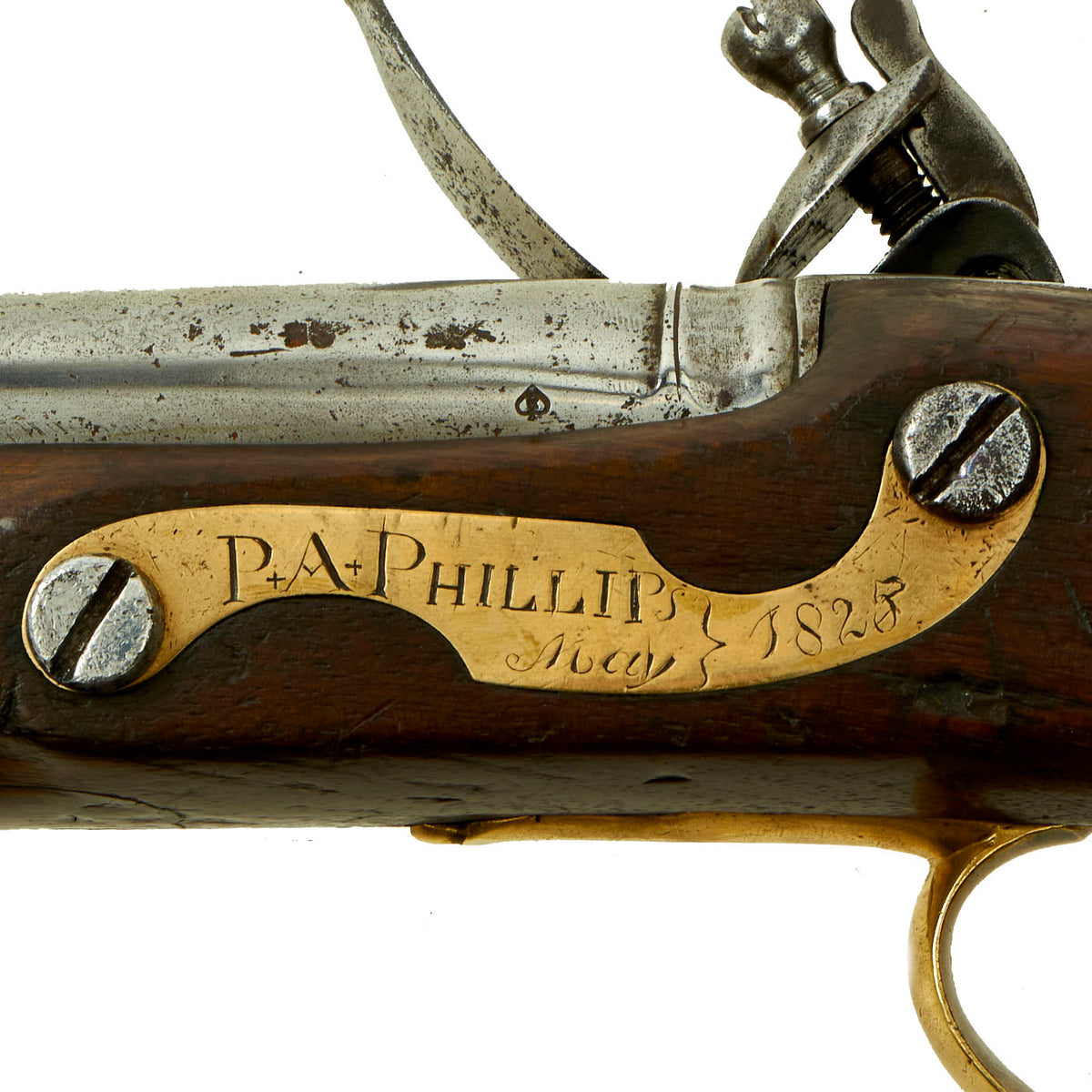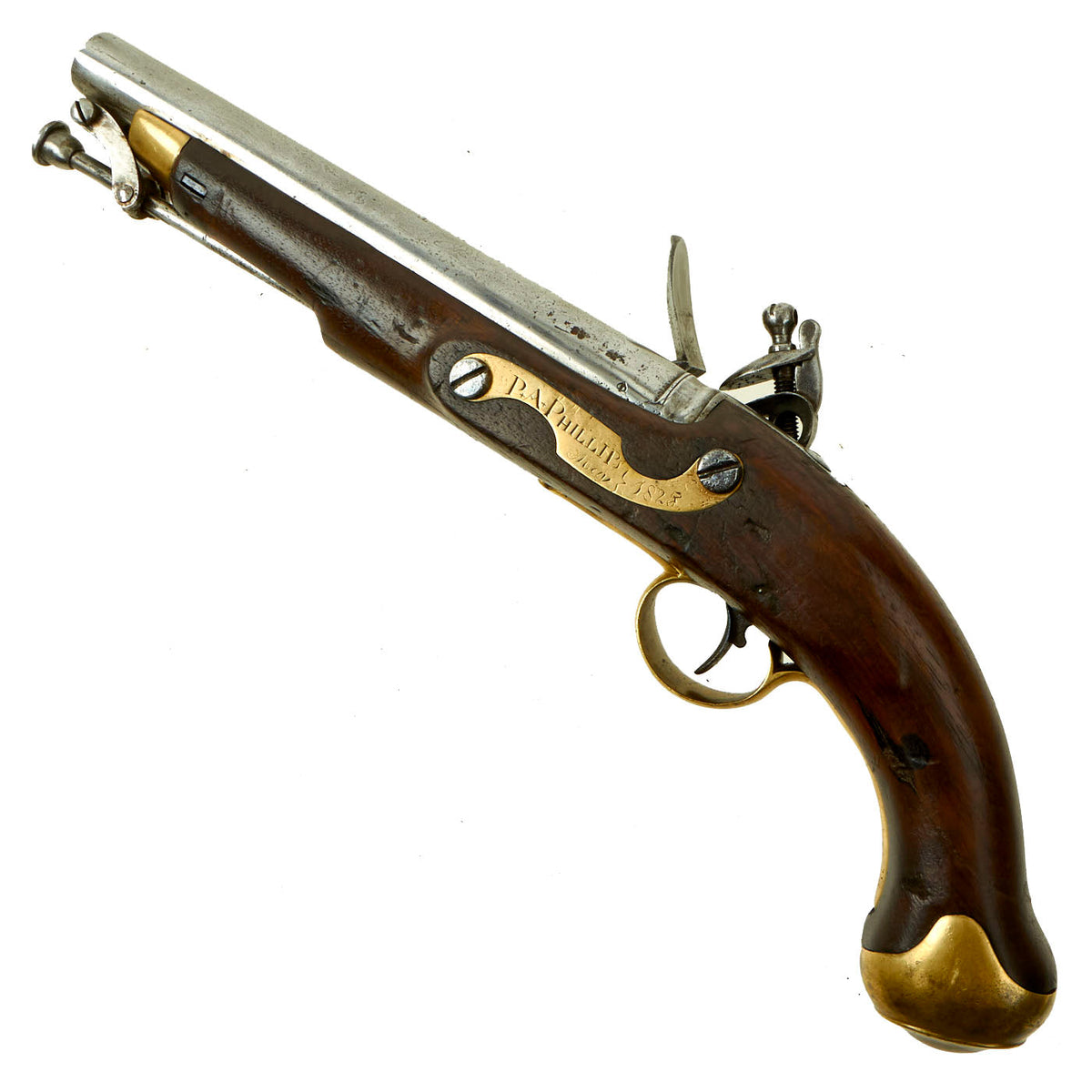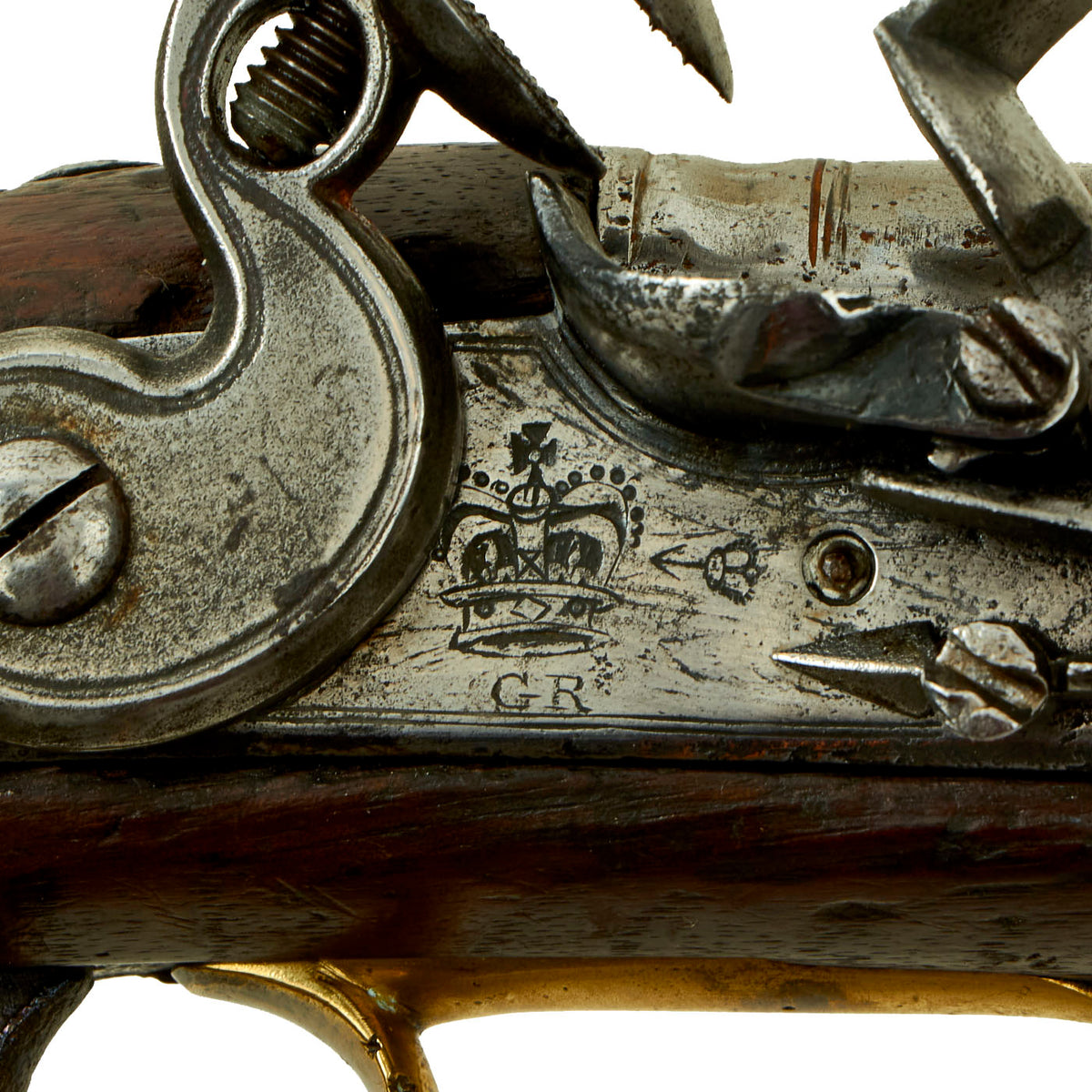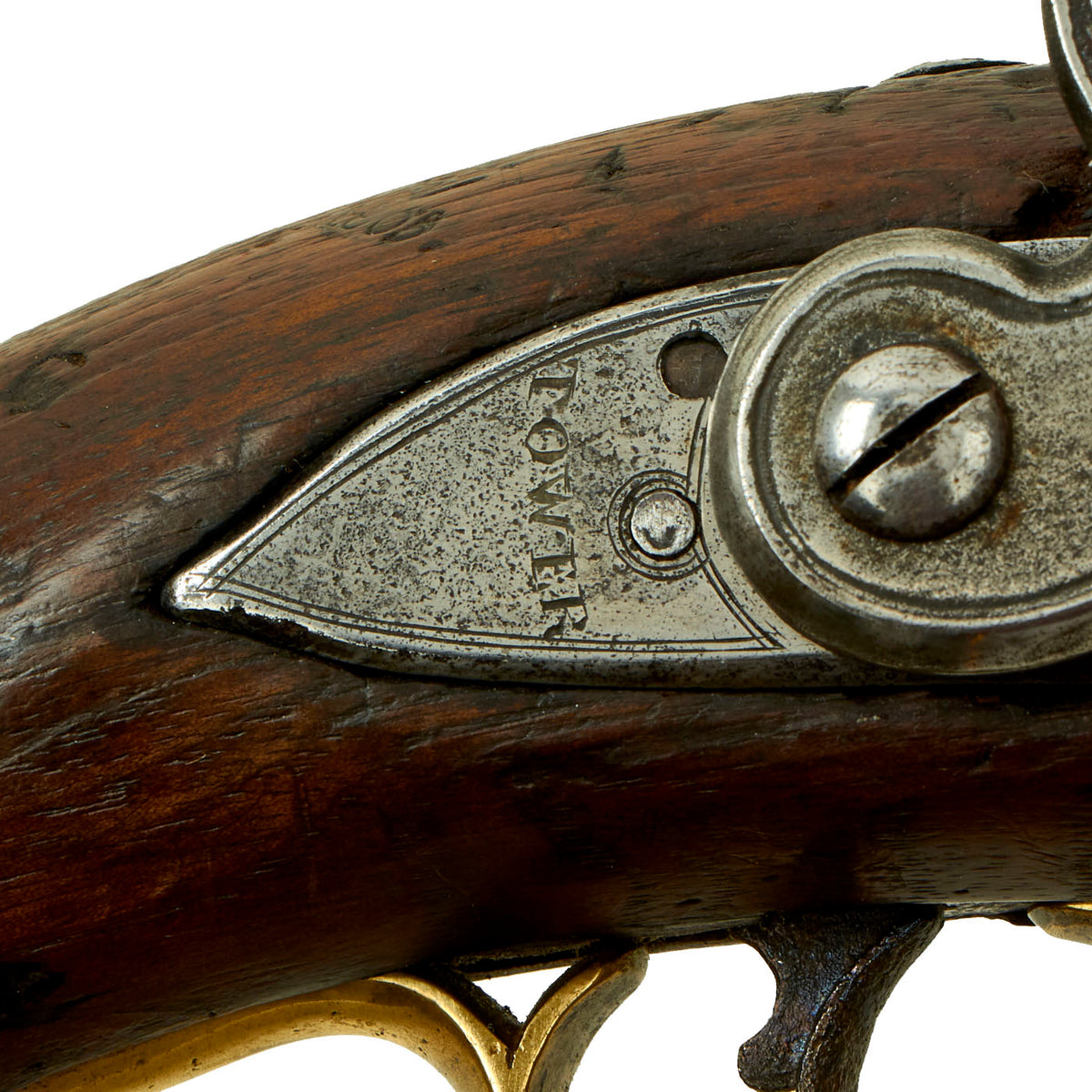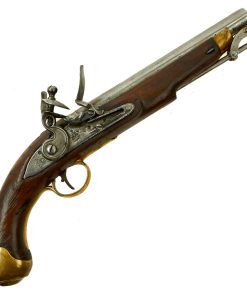Original British Named Napoleonic New Land Pattern Tower Flintlock Pistol marked to the 27th Reg’t of Foot – circa 1810 Original Items
$ 2.995,00 $ 748,75
Original Item: Only One Available. This Lovely “New Land Pattern” flintlock Pistol dates to prior the Battle of Waterloo, and is marked to the 27th (Inniskilling) Regiment of Foot. First raised in June 1689 as a local militia in Northern Ireland at Enniskillen to fight in the Williamite–Jacobite War, it acquitted itself well, and was made a formal regiment of the British Army. In 1751 they were officially titled the 27th (Enniskillen) Regiment of Foot, which in 1761 was changed to use the British spelling of the 27th (Inniskilling) Regiment of Foot. A storied regiment, it took part in the 7 years war and most British conflicts involving France.
The Napoleonic wars were no exception, and the regiment took part in the Egyptian and Peninsular campaigns. The 1st Battalion was first to see action, followed by the 2nd and 3rd battalions. The 1st Battalion faired well, however the 2nd battalion was nearly destroyed at the Battle of Ordal, which took place 12-13 September 1813. The 3rd battalion fared better, having arrived in Lisbon in 1808 before becoming part of Arthur Wellesley, 1st Duke of Wellington’s army, where they fought successfully at many of the key battles during the Peninsular campaign. They then pursued the French Army into France.
After Napoleon’s escape from his exile on the island of Elba, he marshalled his forces, leading to the final Battle of Waterloo. It is in this battle that the 27th Regiment of Foot became most well known, as the 1st battalion fought as part of John Lambert’s 10th Brigade in the 6th Division, and ended up being decimated. At about 6:30 PM, the French captured the key strongpoint of La Haye Sainte farm. After this success, they brought up several cannon and took the Anglo-Allied lines under fire at extremely close range.
At this period, the 698-strong battalion was deployed in square at the point where the Ohain road crossed the Charleroi to Brussels highway. At a range of 300 yards (270 m), the French artillery caused the unit enormous casualties within a short time. At day’s end, the 1st Battalion had lost 105 killed and 373 wounded, a total of 478 casualties, without breaking. The unit was described as “lying dead in a square but did not break”. There are few regiments that can boast of such an achievement.
Marked to the 27th Regiment, here is a very good chance that this pistol was carried by an officer soldier during the Napoleonic wars, and possibly even on the field at Waterloo itself! The pistol is a standard full stocked flintlock pistol fitted with the NEW LAND PATTERN Swivel all steel “captured” ramrod. Introduced in 1808, this allowed a Cavalryman to easily reload the pistol while on horseback without fear of dropping his ramrod.
In fine tight and all original condition showing British Proof marks. It is fitted with the standard 8 3/4″ .67″ smooth bore barrel, which still shows visible proofs on the breech end, a rare thing to see. There is also a BROAD ARROW over what looks to be an 1808 date on the right side of the stock just over the lock plate. The lock itself is marked with Crown over G.R. and TOWER on the lock plate tail, with the CROWN / BROAD ARROW “Lock Viewer’s” mark under the pan. From what we can see, they are the CROWN / GR royal proof and the CROWN / CROSSED SCEPTERS proof for manufacture in Birmingham, England by Ketland, which in 1813 became the proof mark for all of Birmingham produced guns.
Overall condition is very nice, with the expected wear from age and use. The stock has a standard brass nose cap and all brass fittings. The lock functions well, holding at half cock and firing at full. The captured ramrod works as well. The stock is in good condition, though it does show age. There also is a repaired crack going through the grip areas of the stock, and another repair where the ramrod enters the stock.
The top of the barrel is inscribed with the regimental marking XXVII REG’T., and on the trigger guard there are additional markings:
D
—-
41
This would stand for the 27th (Inniskilling) Regiment of Foot, D company, 41st Man. Additionally, the lock side plate has an additional marking:
P + A + PHILLIPS
May 1823.
This could possibly be the last officer to use the pistol, which was probably then taken out of service due to wear. We have not attempted any research on this, and leave it as a great opportunity for further study.
A highly desirable named Flintlock pistol from the Napoleonic Wars from a remarkable British regiment with an action packed history. Ready to display!
Specifications:
Year of Manufacture: circa 1810
Bore Diameter: .67″
Ammunition Type: Lead Ball & Powder
Barrel Length: 8 3/4 inches
Overall Length: 15 1/4 inches
Action: Flintlock Side Action
Feed System: Muzzle-Loaded
NOTE: International orders of antique firearms MUST be shipped using UPS WW Services (courier). USPS Priority Mail international will not accept these. International customers should always consult their country’s antique gun laws prior to ordering.
Fast Shipping with Professional Packaging
Thanks to our longstanding association with UPS FedEx DHL, and other major international carriers, we are able to provide a range of shipping options. Our warehouse staff is expertly trained and will wrap your products according to our exact and precise specifications. Prior to shipping, your goods will be thoroughly examined and securely secured. We ship to thousands clients each day across multiple countries. This shows how we're dedicated to be the largest retailer on the internet. Warehouses and distribution centres can be located throughout Europe as well as the USA.
Note: Orders with more than one item will be assigned a processing date depending on the item.
Before shipping before shipping, we'll conduct a thorough inspection of the items you have ordered. Today, the majority of orders will be delivered within 48 hours. The delivery time will be between 3-7 days.
Returns
The stock is dynamic and we cannot completely manage it because multiple stakeholders are involved, including our factory and warehouse. So the actual stock may alter at any time. It's possible that you may not receive your order once the order has been made.
Our policy is valid for a period of 30 days. If you don't receive the product within 30 days, we are not able to issue a refund or an exchange.
You can only return an item if it is unused and in the same state as the day you received it. You must have the item in its original packaging.
Related products
Uncategorized
Uncategorized
Uncategorized
Uncategorized
Uncategorized
Uncategorized
Uncategorized
Uncategorized
Uncategorized
Uncategorized
Uncategorized
Uncategorized
Uncategorized
Uncategorized
Angolan Rebel 1970s era 60mm Inert Display Mortar from Angolan Civil War Original Items
Uncategorized
Uncategorized
Uncategorized

